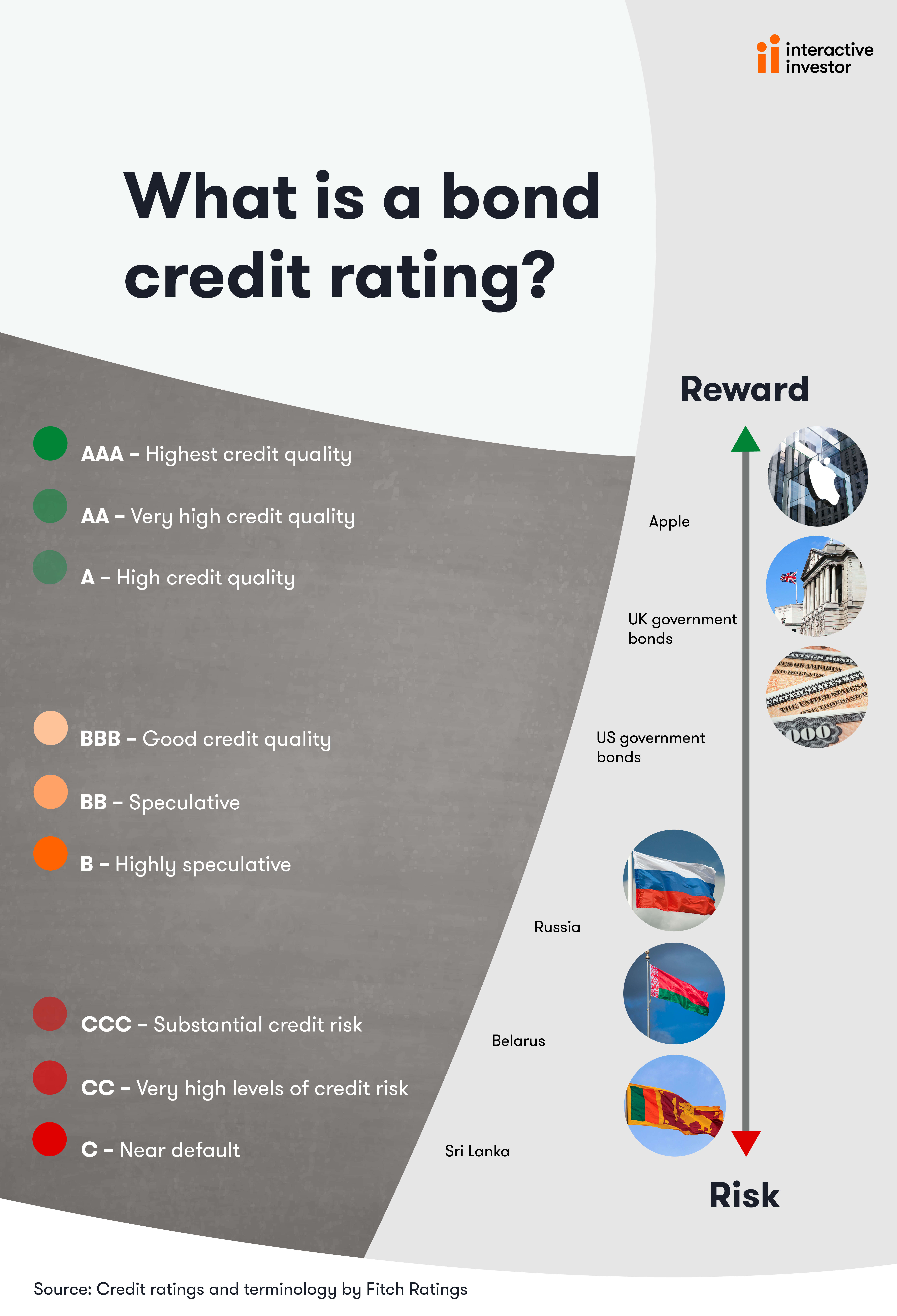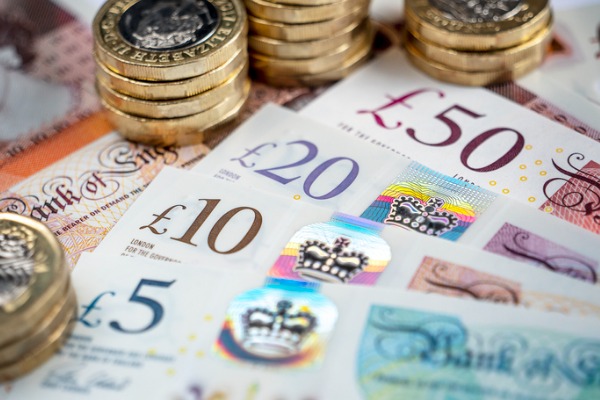The part of the bond market offering ‘rare’ 6%-plus income
31st August 2022 08:59
by Ceri Jones from interactive investor
Over the last 10 years, yields have been higher on only three occasions. Ceri Jones explains why, and asks the bond pros whether the high income levels are sustainable.

High-yield bonds, defined as corporate bonds rated below BBB (see below infographic for a breakdown of credit ratings), are worth considering as a source of attractive income and potential capital appreciation. They typically offer higher coupons than government bonds or high-grade corporate bonds because their default risk is higher, and there is potential for price appreciation if either the economy or performance of the issuing company improves.
Historically, high-yield bond investments have offered similar returns to equity markets, but with lower volatility. From July 1983 to December 2013, US high-yield bonds returned 9.5% compared with the S&P 500’s 10.9%, with about half the risk of stocks. Most of the return comes from income.
- Learn about: How Bonds & Gilts work | Buy Bonds | Opening a Stocks & Shares ISA
Yields (which rise when bond prices fall) are currently above 6% in European high yield markets, and even higher in the US dollar market at 7.5%. This reflects a difficult first half of 2022, with six consecutive months of negative total returns as monetary and fiscal policy tightened across Europe and the US.
However, high-yield bond prices gained 5.9% in July, their biggest one-month rally in a decade, and they have been rising in August as well, suggesting that many investors do not believe the recession will be as deep, nor interest rate rises as sharp, as the doom-mongers imply.
Rising inflation coupled with an economic slowdown and rising interest rates is the resounding consensus view – few commentators would be brave enough to argue anything else. But a sharp recession could see central bankers ceasing or even reversing interest rate rises and restarting quantitative easing.
Similarly, signs that inflation is past its peak could encourage central bankers to halt or reverse rate rises and the data on inflation is not at all clear. For example, the Institute of Supply Management survey of purchasing managers shows that raw material prices are still rising, but at a slower rate than for many months.

High-yield credit looking healthier
Another reason high-yield bonds have been attracting renewed interest is that the current default environment is unusually benign. The extended period of uncertainty around the pandemic has encouraged companies to manage their balance sheets conservatively, so leverage, margins, and free cash flow have improved.
The defaults trigged by the pandemic, which peaked at 6.3% in October 2020, has also taken the weaker companies out of the investible universe, leaving those of greater quality in the sector, while simultaneously many fallen angels have been demoted into the high-yield market. In fact, BB- rated bonds now account for more than half of the high-yield universe.
“Even after the adjustment we observed over July, yields are still sitting above 6%,” says James Durance, a bond fund manager at Fidelity International.
Durance adds: “However, the situation today is very different to major past economic shocks where yields have been higher such as at the beginning of the Covid-19 pandemic, the global financial crisis, and the European sovereign wealth crisis.
“Whereas defaults will rise from here, we don’t expect these to significantly exceed long-term average levels of around 3%. Companies have been prudent enough to refinance their debt at favourable levels post-Covid, which has pushed the maturity wall further into the future, ensuring that there won’t be any imminent liquidity concerns for most of the European high-yield market.”

Current high levels of income on offer are rare
Historically, periods of such high yields are relatively rare. Over the last 10 years, yields have been only three times higher than the current level of 6% on those three occasions. Each time, yields did not stay at these high levels for long. Indeed, a strong and rapid bounce-back after a period of escalating yields is a characteristic of the high-yield market.
“The valuation picture is more attractive than it has been for a long while, whether you look at it on a spread or outright yield basis,” says Thomas Hanson, head of Europe high-yield and fixed income at Aegon AM.
Hanson adds: “Historically, you haven’t had that many opportunities to access the market on a yield north of 8%, and when you have, the subsequent returns have been fairly attractive.”
“We’ve typically favoured lower-rated credits within the Aegon High Yield bond funds over recent quarters, but so far this year we have been pursuing an up-in-quality approach, while trimming more cyclical exposure.”
“Bonds with a credit rating of BB had been generally uninteresting to us for a long time, but some compelling opportunities now present themselves. In sector terms, we have been adding to the telecommunications space, for example, while reducing automotive exposure.”
- Watch our video with Ariel Bezalel: an 8% bond yield and the 'biggest opportunity' for some time
- Watch our video with Ariel Bezalel: why interest rates will fall in 2023 and how we are profiting
Several fund managers said they are shunning consumer discretionary in favour of more defensive sectors such as utilities, telecoms and packaging. However, every borrower is different. For example, Baillie Gifford lends to flooring manufacturer Victoria (LSE:VCP), a business materially impacted by cost inflation, the prospect of falling consumer demand and gas supply risk.
“Victoria successfully passed through material price rises last year, reflecting the strength of its product proposition,” says Robert Baltzer, head of credit and co-manager of the Baillie Gifford High Yield Bond fund.
Baltzer adds: “I don’t think the market fully recognises the value of Victoria’s low operational gearing. Management was able to quickly reduce costs in the early days of the pandemic.
“It’s easy to forget that a lot of management teams have just experienced a sharp demand shock, and the discerning investor can identify those that managed this experience well. There are a lot of resilient businesses in the market at attractive valuations.”
Baillie Gifford also recently lent to UK car leasing company Zenith. “We don’t believe inflation is a material issue for their business because inflation is broadly supportive of used car prices,” says Baltzer.
“In addition, demand for vehicle leasing can pick up in a downturn as corporates and consumers shun ownership. The company has evidenced steady and predictable growth and financial performance through the financial crisis, the European debt crisis, Brexit, Dieselgate and the pandemic. Nevertheless, as a smaller B-rated issuer, the bonds have been at the sharp end of the sell-off, an example of valuations moving out of sync with fundamentals at company level.”
‘7% returns are sustainable’
Baltzer is confident that 7% returns are sustainable in the high-yield market. “I think it’s incredible that we’re asking the question,” he adds. “This is a reflection of how accustomed we have become to the ultra-loose financial conditions and very low yields since 2008. I have never assumed that low financing costs will persist indefinitely.”
The Liontrust Strategic Bond fund currently has 27% in high yield (anything above 20% is deemed to be overweight), with a strong defensive tilt and no CCC- rated bonds.
“We are leaving room to add more if sentiment deteriorates and have recently been trimming a little European exposure after a very strong July,” says Phil Milburn, co-manager on the Liontrust Strategic Bond Fund.
He adds: “We seek to reinvest the proceeds in US high-yield debt on any market weakness as we believe the risk/return on offer there is very attractive.
“So, is high yield cheap? If you think there won’t be a deep recession, then yes. With myriad risks to be faced over the next few quarters, I’ve left some room to buy more during bouts of volatility and, obviously, stock picking is paramount.”
- Vanguard says ‘bonds are back’ following worst spell for 150 years
- A guide on how investors can protect against inflation
Active funds best way to play high yield
Every fund manager will tell you that their market is best suited to active management, but in the high-yield bond sector it is critical, as individual bonds even from the same issuer vary in significant ways, including maturity profile, coupon, seniority and covenants of specific issues. This matters less in bull markets, but overlooking these nuances could be perilous in bear markets.
In terms of portfolio construction, however, high-yield bonds are closely correlated with stocks, linked as they are to the business results and fundamentals of the issuing company. Therefore, they do not offer the same diversification benefits as higher-quality credit, such as UK and US government bonds.
These articles are provided for information purposes only. Occasionally, an opinion about whether to buy or sell a specific investment may be provided by third parties. The content is not intended to be a personal recommendation to buy or sell any financial instrument or product, or to adopt any investment strategy as it is not provided based on an assessment of your investing knowledge and experience, your financial situation or your investment objectives. The value of your investments, and the income derived from them, may go down as well as up. You may not get back all the money that you invest. The investments referred to in this article may not be suitable for all investors, and if in doubt, an investor should seek advice from a qualified investment adviser.
Full performance can be found on the company or index summary page on the interactive investor website. Simply click on the company's or index name highlighted in the article.